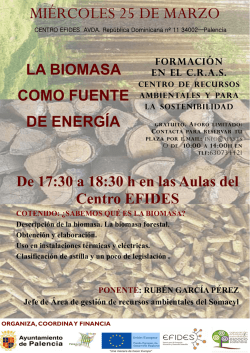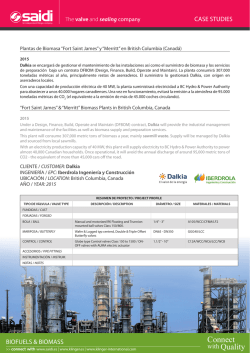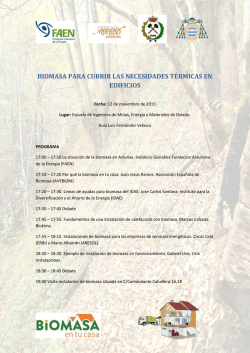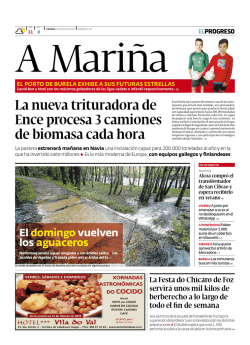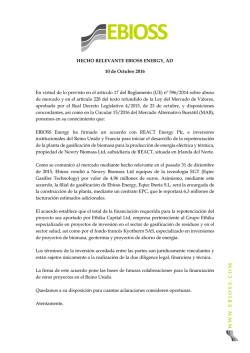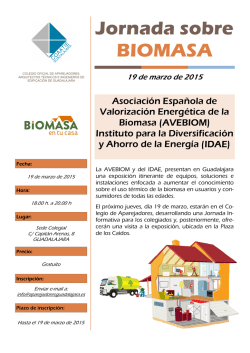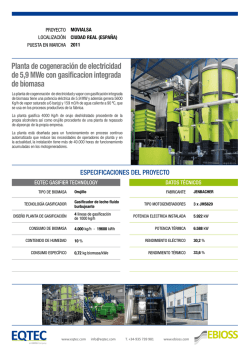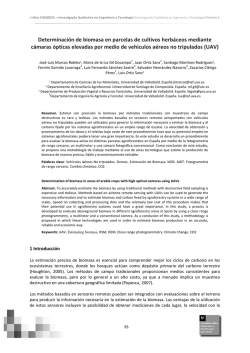
Allometric equations commonly used for estimating shoot biomass in
Scientific note doi: 10.5154/r.rchscfa.2015.05.022 Allometric equations commonly used for estimating shoot biomass in shortrotation wood energy species: a review Ecuaciones alométricas de uso común para estimar biomasa en rebrotes de especies dendroenergéticas de corta rotación: una revisión Julio Cesar Ríos-Saucedo1,3*; Eduardo Acuña-Carmona1; Jorge Cancino-Cancino1; Rafael Rubilar-Pons1; José de Jesús Navar-Chaidez2; Rigoberto Rosales-Serna3. Universidad de Concepción, Facultad de Ciencias Forestales. Victoria núm. 631, Barrio Universitario, Concepción, Región del Biobío - Chile / Casilla 160-C. C.P. 4070386. Tel. Cel +56 9 74203583. Email: [email protected] (*Corresponding author). 2 Tecnológico de Monterrey, Campus Monterrey. Edificio CEDES 4º Piso, Av. Eugenio Garza Sada núm. 2501 Sur Col. Tecnológico, C. P. 64849. Monterrey, Nuevo León, México. 3 Instituto Nacional de Investigaciones Agrícolas y Pecuarias, Campo Experimental Valle del Guadiana. Carretera Durango-Mezquital, km. 4.5. C.P. 34000. Durango, Dgo., México. 1 Abstract W Keywords: Woody crops, allometric model, bioenergy, Scopus, Web of Science. ood energy crops in a short rotation coppice (SRC) commonly consist of singlestem tree individuals in the first short cycle, but from the second cycle onward numerous sprouts or shoots emerge from each stump, resulting in interesting challenges when estimating their biomass. The aim of this study was to identify species, rotation length and types of allometric models used to estimate biomass in SRC through a detailed search of the scientific journals in the Scopus and Web of Science databases. Among the most commonly used models to estimate biomass (y) is the typical exponential model, which has the following predictors: diameter at breast height (D) (y= b0Db1), stem basal diameter (Db) (y = b0Dbb1) and the combination of diameter at breast height squared by total height (D2H) (y = b0 + b1D2H), stands out. The genera with the largest number of different models were Populus, Salix and Eucalyptus. The first two are the most studied. The rotation length used in the crops studied ranged from one to 15 years. Resumen L Palabras clave: Cultivos leñosos, modelos alométricos, bioenergía, Scopus, Web of Science. os cultivos dendroenergéticos de corta rotación en monte bajo (Short Rotation Coppice -SRC) comúnmente están formados por individuos unifustales en el primer ciclo de corta, pero a partir del segundo ciclo, de cada cepa surgen numerosos vástagos o brotes, los cuales presentan desafíos interesantes al momento de estimar su biomasa. El objetivo de este trabajo fue identificar especies, longitud de rotación y tipos de modelos alométricos usados para estimar biomasa en SRC, en revistas científicas de las bases de datos Scopus y Web of Science. Entre los modelos para estimar la biomasa (y) de uso más frecuente destaca el exponencial, que tiene como variable predictora el diámetro normal (D) (y = b 0Db1), diámetro basal de tallo (Db) (y = b0Dbb1) y la combinación de diámetro normal al cuadrado por la altura total (D2H) (y = b 0 + b1D2H). Los géneros con mayor número de modelos diferentes fueron Populus, Salix y Eucalyptus. Los dos primeros son los más estudiados. La longitud de rotación empleada en los cultivos estudiados varió de uno a 15 años. Please cite this article as follows (APA 6): Ríos-Saucedo, J. C., Acuña-Carmona, E., Cancino-Cancino, J., RubilarPons, R., Navar-Chaidez, J. J., & Rosales-Serna, R. (2016). Allometric equations commonly used for estimating shoot biomass in short-rotation wood energy species: a review. Revista Chapingo Serie Ciencias Forestales y del Ambiente, 22(2), 193-202. doi: 10.5154/r.rchscfa.2015.05.022 Received: May 13, 2015 / Accepted: February 24, 2016. www.chapingo.mx/revistas/forestales 194 Allometric equations commonly... Introduction Introducción Global demand for energy is growing steadily, resulting in higher prices for fossil fuels, which represent the most important input for the energy industry. Sustainable energy sources currently provide 19 % of global energy consumption, and of this amount 50 % is generated from the combustion of plant biomass (REN21, 2013). La demanda mundial de energía crece de manera constante y esto propicia la escalada en el precio de los combustibles fósiles, los cuales representan el insumo más importante para la industria energética. En la actualidad, las fuentes de energía sostenible aportan 19 % del consumo energético mundial, y de esta cantidad el 50 % se genera a partir de la combustión de biomasa vegetal (REN21, 2013). Many woody species grown in short rotation coppices (SRC) have gained importance in the supply of plant biomass (Hoogwijk, Faaij, Eickhout, de Vries, & Turkenburg, 2005). Among the most important wood energy species worldwide are eucalyptus (Eucalyptus globulus, E. nitens, E. denticulata) (Camps & Marcos, 2002), willow (Salix spp.), poplar (Populus spp.) and acacia (Acacia dealbata, A. melanoxylon, A. retinodes). These species have high productivity and can be promoted as fast-growing forest plants (Hoogwijk et al., 2005). Evidence indicates that an important way to produce the biomass used in power generation is through the development of fast-growing plantations and short rotations. Interest in sprouting-generated stands lies mainly in the fact that they produce on average twice the volume of a sexual-regeneration stand in the first eight years (Sixto, Hernández, Barrio, Carrasco, & Cañellas, 2008) . Biomass estimation is usually done using allometric models based on diameter at breast height (D) and total tree height (H), and occasionally some tree form measurements are also used (Clutter, Fortson, Pienaar, Brister, & Bailey, 1983). Allometric models have been developed for use in wood energy species grown in Africa (Henry et al., 2011), Europe (Muukkonen & Mäkipää, 2006) and South America (Návar, 2009). These models are based on characteristics easily measured on single-stem trees, such as the variables diameter at breast height and plant height, which together with the basic wood density should be related to biomass production (Hauk, Knoke, & Wittkopf, 2014). However, in wood energy crops only the first rotation is formed by single-stem trees. From the second rotation onwards, numerous shoots emerge from each stump, which presents difficulties for predicting the total biomass yield in the aboveground part and its components. Therefore, it was decided to conduct a literature review with the objective of identifying species, rotation length and types of allometric models used to estimate biomass in SRC. For this reason, a bibliographic compiling of scientific publications related to the use of species, rotation length and allometric models for estimating aboveground biomass in SRC was performed. Numerosas especies leñosas cultivadas en turnos cortos (SRC) han adquirido importancia en la oferta de biomasa vegetal (Hoogwijk, Faaij, Eickhout, de Vries, & Turkenburg, 2005). Entre las especies dendroenergéticas más importantes a nivel mundial se encuentran el eucalipto (Eucalyptus globulus, E. nitens, E. denticulata) (Camps & Marcos, 2002), sauce (Salix spp.), álamo (Populus spp.) y acacia (Acacia dealbata, A. melanoxylon, A. retinodes). Estas especies presentan una alta productividad y pueden promoverse como plantas forestales de rápido crecimiento (Hoogwijk et al., 2005). La evidencia señala que una importante vía para producir la biomasa utilizada en la generación de energía, es a través del desarrollo de plantaciones de rápido crecimiento y rotaciones cortas. El interés en rodales de rebrotación radica principalmente en que producen en promedio el doble del volumen de un rodal de regeneración sexual en los primeros ocho años (Sixto, Hernández, Barrio, Carrasco, & Cañellas, 2008) . La biomasa se estima habitualmente mediante modelos alométricos basados en el diámetro normal (D) y la altura total del árbol (H), y en ocasiones también se utilizan algunas medidas de la forma de los árboles (Clutter, Fortson, Pienaar, Brister, & Bailey, 1983). Se han desarrollado modelos alométricos para su uso en especies dendroenergéticas cultivadas en África (Henry et al., 2011), Europa (Muukkonen & Mäkipää, 2006) y América del Sur (Návar, 2009). Dichos modelos están basados en características de fácil medición en árboles unifustales, como son las variables diámetro normal y altura de la planta, las cuales junto con la densidad de la madera deben relacionarse con la producción de biomasa (Hauk, Knoke, & Wittkopf, 2014). Sin embargo, en los cultivos dendroenergéticos sólo la primera rotación está formada por individuos monofustales. A partir de la segunda rotación surgen numerosos vástagos o rebrotes de cada tocón, lo cual presenta dificultades para la predicción del rendimiento de biomasa total en la parte aérea y sus componentes. Así surgió el interés por realizar una revisión bibliográfica con el objetivo de identificar especies, longitud de rotación y tipos de modelos alométricos usados para estimar biomasa en SRC. Para esto se realizó una recopilación bibliográfica de publicaciones científicas, relacionadas con el uso de Revista Chapingo Serie Ciencias Forestales y del Ambiente | Vol. XXII, núm. 2, mayo-agosto 2016. Ríos-Saucedo et al. Materials and methods especies, longitud de rotación y modelos alométricos para estimar biomasa aérea en SRC. Creating the database Materiales y métodos An online search was conducted of scientific journals included in the Scopus and Web of Science (WoS) databases. The review included all the recorded years of journals indexed in the two databases until April 2015. The general search criterion for the publications was short rotation coppice, and included the five following concepts: short rotation coppice (SRC), short rotation forestry (SRF), short rotation woody crops (SRWC), short rotation intensive culture (SRIC) and bioenergy crops (BC). These concepts were combined with the following five keywords: allometry, allometric, model, equation and partition, in order to increase the level of specificity in each of the five concepts related to the criterion of short rotation coppice. Compilation and analysis of publications All publications found for all possible combinations of the concepts and keywords were reviewed, excluding those publications that, despite matching the search criteria, lacked mathematical models for estimating biomass. Documents obtained were exported to “EndNote X6” software, in order to join the two databases and remove duplicates automatically. The final database included only those publications in which the allometry mentioned was related to allometric models for estimating biomass produced by shoots in short rotation coppice systems. Results and discussion Using the criteria, concepts and simple and compound key words, defined for the study, 1,382 papers published between 1996 and 2015 were compiled. Most of the publications came from the Scopus database. The most frequently used concept was bioenergy crops, which allowed the identification of 492 publications (36 % of the total), of which 362 were obtained from the Scopus database and 130 from WoS. Another important concept was short rotation coppice, which recorded 420 publications (30 %), of which 282 were obtained from Scopus and 138 from WoS. The concepts that appeared with less frequency were short rotation forestry (260 publications), short rotation woody crops (140), short rotation intensive culture (42) and short rotation crops (28) (Table 1). The combination of the keyword (Model) with all concepts showed a greater record of publications in both databases (1,072 papers), but without the presence of allometric equations for estimating biomass (Table 1). After article purification, based on duplications and content type, only 65 publications that showed allometry aimed at Creación de la base de datos Se realizó la búsqueda en línea de las revistas científicas incluidas en las bases de datos Scopus y Web of Science (WoS). La revisión incluyó todos los años de registro de las revistas indexadas en las dos bases de datos hasta el mes de abril de 2015. El criterio general de la búsqueda de publicaciones fue short rotation coppice (monte bajo de corta rotación), y se incluyeron los siguientes cinco conceptos: short rotation coppice (SRC), short rotation forestry (SRF), short rotation woody crops (SRWC), short rotation intensive culture (SRIC) y bioenergy crops (BC). Estos conceptos se combinaron con las siguientes cinco palabras clave: allometry, allometric, model, equation y partition, con el fin de incrementar el nivel de especificidad en cada uno de los cinco conceptos relacionados con el criterio de monte bajo de corta rotación. Recopilación y análisis de publicaciones El número total de publicaciones encontradas para todas las posibles combinaciones de los conceptos y palabras clave fueron revisadas, excluyendo aquellas publicaciones que, a pesar de coincidir con los criterios de búsqueda, carecieron de modelos matemáticos para la estimación de biomasa. Los documentos obtenidos se exportaron al software “EndNote X6”, con el fin de unir las dos bases de datos y eliminar los duplicados de manera automática. La base de datos final incluyó únicamente las publicaciones en las que la alometría estaba relacionada con modelos alométricos para la estimación de biomasa producida por los rebrotes en sistemas de monte bajo de corta rotación. Resultados y discusión Mediante el uso del criterio, conceptos y palabras clave simples y compuestas, definidos para el estudio, se recopilaron 1,382 artículos publicados entre 1996 y 2015. La mayor parte de las publicaciones provinieron de la base de datos Scopus. El concepto de uso más frecuente fue bioenergy crops, que permitió la identificación de 492 publicaciones (36 % del total), de las cuales 362 se obtuvieron de la base de datos Scopus y 130 de WoS. Otro concepto importante fue short rotation coppice, que registró 420 publicaciones (30 % del total); 282 se obtuvieron de Scopus y 138 en WoS. Los conceptos que presentaron menor frecuencia fueron short rotation forestry (260 publicaciones), short rotation woody crops (140), short rotation intensive culture (42) y short rotation crops (28) (Cuadro 1). La combinación de la palabra clave (Model) con todos los conceptos Revista Chapingo Serie Ciencias Forestales y del Ambiente | Vol. XXII, núm. 2, mayo-agosto 2016. 195 196 Allometric equations commonly... Table 1. Number of publications compiled according to concept, keywords and database consulted. Cuadro 1. Número de publicaciones recopiladas, según concepto, palabras clave y base de datos consultada. Concepts / Conceptos Keyword / Palabra clave SRC Scopus SRF WoS Scopus SRWC WoS Scopus WoS SRCR SRIC BC Scopus WoS Scopus WoS Scopus WoS Allometry / Alometricas 20 4 10 7 7 0 1 0 0 0 8 0 Allometric / Alométricas 22 11 17 12 7 5 2 1 2 0 4 1 208 98 106 52 74 26 18 11 19 11 328 121 Equation / Ecuación 31 17 32 16 14 2 1 0 5 2 20 3 Partition / Partición 1 8 1 5 1 2 0 0 0 1 2 5 Model / Modelo SRC: short rotation coppice, SRF: short rotation forestry, SRWC: short rotation woody crops, SRCR: short rotation crops, SRIC: short rotation intensive culture, BC: bioenergy crops. estimating biomass were selected. Of these, 52 (82 %) were associated with the SRC concept and 13 (20 %) with the BC concept. The 65 identified publications were examined in detail in order to select only those articles that explicitly showed models and variables for predicting shoot biomass in short rotation crops. Through this analysis only 25 publications were detected. Of these, a high number, 12 (48 %), were related to hybrid plantations of the genus Populus, which were established in countries such as Germany, Italy, Belgium, the Czech Republic, Denmark and France. The other publications were based on plantations of other plant genera, such as Salix (4 papers), established in Sweden, Denmark and Croatia, and Eucalyptus (2 papers) in Madagascar and France. There were also individual publications on mixed cultures of the genera Populus-Salix (Czech Republic), LiquidambarPlatanus (Georgia), Acer-Populus (Belgium), Alnus-Betula (Estonia), Daniellia (Benin), Platanus (USA) and Robina (Germany). The genus Populus was the most common in the studies that generated allometric models to estimate aboveground shoot biomass (Table 2). Other plant genera important in developing SRC models are Salix and Eucalyptus. The studies were carried out with different clones, interspecific hybrids and a rotation length from one to 15 years. The rotation length used in the crops studied is very variable; in seven studies conducted with different plant genera, biomass was estimated at only a single rotation, as was the case of Acer, Alnus, Betula, Daniellia, Liquidambar and two in Platanus. Most of these were evaluated at age eight, except for Acer (4 years) and mostró mayor registro de publicaciones en ambas bases de datos (1,072 artículos), pero sin presencia de ecuaciones alométricas para estimar biomasa (Cuadro 1). Después de la depuración de artículos, con base en duplicaciones y tipo de contenido, se seleccionaron solo 65 publicaciones que mostraron la alometría de forma dirigida a la estimación de biomasa, de éstas, 52 (82 %) asociadas al concepto SRC, y 13 (20 %) a BC. Las 65 publicaciones identificadas se examinaron en forma detallada, para seleccionar únicamente aquellos artículos que mostraron explícitamente modelos y variables para predecir la biomasa de rebrotes en cultivos de corta rotación. Mediante ese análisis se detectaron solo 25 publicaciones. De estas, una alta cantidad 12 (48 %) se relaciono con plantaciones de híbridos del género Populus, establecidas en países como Alemania, Italia, Bélgica, República Checa, Dinamarca y Francia. El resto de las publicaciones se generaron en plantaciones de otros géneros vegetales, como Salix (4 artículos), en Suecia, Dinamarca y Croacia, Eucalyptus (2 artículos) en Madagascar y Francia, también publicaciones individuales en cultivos mixtos de los géneros PopulusSalix (República Checa), Liquidambar-Platanus (Georgia), Acer-Populus (Bélgica), Alnus-Betula (Estonia), Daniellia (Benín), Platanus (EUA) y Robina en Alemania. El género Populus fue el más frecuente en los estudios que generaron modelos alométricos para estimar biomasa aérea en rebrotes (Cuadro 2). Otros géneros vegetales importantes en desarrollo de modelos en SRC, son Salix y Eucalyptus. Las investigaciones fueron realizadas con diferentes clones, híbridos interespecíficos y longitud de rotación desde uno hasta 15 años. Revista Chapingo Serie Ciencias Forestales y del Ambiente | Vol. XXII, núm. 2, mayo-agosto 2016. Ríos-Saucedo et al. Daniellia (3 years). However, the genus Eucalyptus, reported in two studies, showed greater assessment variability over time (1, 2, 3, 5, 6, 10, 13, 14 and 15 years), followed by the genera Robina (2, 3, 4 and 14 years), Populus (3, 4 and 8 years) and Salix (1, 2, 4 and 6 years) (Figure 1). It was found that different models are applied to estimate biomass in tree species from short rotation crops (Table 2), established mainly in the continents of Europe, Africa and North America, among which the typical exponential model y = b0Db1, tested in most species studied, except Eucalyptus, Alnus, Betula and Liquidambar, stands out. This model was used by Laureysens, Bogaert, Blust, and Ceulemans (2004), Liberloo et al. (2005), Liberloo et al. (2006), Rock (2007), Röhle, Hartmann, Gerold, Steinke, and Schröder (2006), Vande Walle, Van Camp, Van de Casteele, Verheyen and Lemeur (2007), Al Afas, Marron, Van Dongen, Laureysens, and Ceulemans (2008), Fajman, Palát, and Sedlák (2009), Avohou, Houehounha, Glele-Kakai, Assogbadjo, and Sinsin (2011), Fischer, Trnka, Kučera, Fajman, and Žalud (2011),Sevel, NordLarsen, and Raulund-Rasmussen (2012) and Mugasha et al. (2013), where some researchers measured each shoot as a single stem and others performed pruning on the stump, leaving one or two shoots, measuring stem diameter (D) at different heights depending on the species studied, in order to find the best model fit and thereby increase the level of correlation and accuracy of the estimates, which showed coefficients of determination (R2) greater than 0.85. In willow (Salix), the biomass values obtained with the destructive method and those estimated with allometric equations (non-destructive) were compared. It was concluded that the exponential model y = b0Db1 was efficient and can be used in commercial willow plantations for estimating aboveground shoot biomass. Based on the results, the height with the greatest coefficient of determination was obtained by measuring the diameter of the stem at 105 cm (R2-adj ≥ 0.99), although heights of 85 and 55 cm (both with R2-adj ≥ 0.97) also showed acceptable prediction values and can be thus used when the crop is in its initial stage of development and has not reached one meter high. In Populus, Guidi, Piccioni, Ginanni and Bonari (2008) validated the exponential model to estimate the production of woody biomass and the amount of bark on the stem, based on its diameter at breast height (D), efficiently estimating the amount of total biomass with and without bark, as the best relationship between stem diameter and tree biomass. The typical exponential model y = b0χb1 has been modified based on the results of different studies aimed at determining biomass with allometric relationships at different diameters (D), basal diameter (Db) and total La longitud de rotación empleada en los cultivos estudiados es muy variable. En siete estudios realizados con diferentes géneros vegetales se estimó la biomasa a una sola rotación, como fue el caso de Acer, Alnus, Betula, Daniellia, Liquidambar y dos en Platanus. La mayoría fueron evaluados a los ocho años, a excepción de Acer (4 años) y Daniellia (3 años). Por otra parte, el género Eucalyptus, reportado en dos estudios, mostró mayor variabilidad de evaluación en el transcurso del tiempo (1, 2, 3, 5, 6, 10, 13, 14 y 15 años), le siguieron los géneros Robina (2, 3, 4 y 14 años), Populus (3, 4 y 8 años) y Salix (1, 2, 4 y 6 años) (Figura 1). Se identificó la aplicación de diferentes modelos para estimar la biomasa en especies arbóreas a partir de cultivos de corta rotación (Cuadro 2), establecidos principalmente en los continentes de Europa, África y Norte de América, de los que sobresale el modelo típico exponencial y = b0Db1, probado en la mayoría de las especies estudiadas, con excepción de Eucalyptus, Alnus, Betula y Liquidambar. Este modelo fue utilizado por Laureysens, Bogaert, Blust, y Ceulemans (2004), Liberloo et al. (2005), Liberloo et al. (2006), Rock (2007), Röhle, Hartmann, Gerold, Steinke, y Schröder (2006), Vande Walle, Van Camp, Van de Casteele, Verheyen, y Lemeur (2007), Al Afas, Marron, Van Dongen, Laureysens, y Ceulemans (2008), Fajman, Palát y Sedlák (2009), Avohou, Houehounha, Glele-Kakai, Assogbadjo, y Sinsin (2011), Fischer, Trnka, Kučera, Fajman, y Žalud (2011), Sevel, Nord-Larsen, y Raulund-Rasmussen (2012) y Mugasha et al. (2013), Algunos de estos investigadoresmidieron cada vástago como un solo tallo y otros realizaron podas en la cepa o tocón, dejando uno o dos vástagos, midiendo el diámetro del tallo (D) a diferentes alturas según la especie estudiada, con el propósito de encontrar el mejor ajuste del modelo y con ello incrementar el nivel de correlación y precisión de las estimaciones, lo cual mostró coeficientes de determinación (R2) superiores a 0.85. En los estudios de sauce (Salix), los valores de biomasa obtenidos con el método destructivo se compararon con aquellos estimados con ecuaciones alométricas (no destructivo). Se concluyó que el modelo exponencial y = b0Db1 fue eficiente y puede utilizarse en plantaciones comerciales de sauce para la estimación de biomasa aérea en rebrotes. Con base en los resultados, la altura con mayor coeficiente de determinación se obtuvo al medir el diámetro del tallo a los 105 cm (R2-adj ≥ 0.99), aunque a la altura de 85 y 55 cm (R2-adj ≥ 0.97) también mostraron valores aceptables de predicción, pudiendo ser utilizados cuando el cultivo está en su etapa inicial de desarrollo y no alcance el metro de altura. En Populus, Guidi, Piccioni, Ginanni y Bonari (2008) validaron el modelo exponencial para estimar la producción de biomasa leñosa y cantidad de corteza en el tallo, con base en el diámetro normal 1.30 m (D), estimando de manera eficiente la cantidad de biomasa total con Revista Chapingo Serie Ciencias Forestales y del Ambiente | Vol. XXII, núm. 2, mayo-agosto 2016. 197 198 Allometric equations commonly... Table 2. Allometric models used in published articles, rotation length, plant genera, countries and source. Cuadro 2. Modelos alométricos utilizados en artículos publicados, longitud de rotación, géneros vegetales, países y fuente. Model / Modelo y = b0 Db1 Genus / Género y = b0 + b1Db2 y = b0Db1 y = b0 + b1D2H lnyagb = b0 +b1 ln (Dbi ) lnyagb = b0 + b1 ln (Ciri ) Country / País Source / Fuente Acer, Salix, Populus 4 Belgium Vande Walle, Van Camp, Van de Casteele, Verheyen, and Lemeur (2007) Populus 4 Belgium Laureysens, Bogaert, Blust, & Ceulemans (2004) Populus 3 Italy Liberloo et al. (2005) Populus 3 Italy Liberloo et al. (2006) Populus 2 Italy Guidi, Piccioni, Ginanni, and Bonari (2008) Populus 2 and 3 Belgium Al Afas, Marron, Van Dongen, Laurey sens, and Ceulemans (2008) Populus 8 Germany Rock (2007) Populus 8 Tanzania Mugasha et al. (2013) Populus 8 Czech Republic Fischer, Trnka, Kučera, Fajman, and Žalud (2011) Populus-Salix 7 Czech Republic Fajman, Palát, and Sedlák (2009) Denmark Sevel, Nord-Larsen, and Raulund-Rasmus sen (2012) Salix y = b0 + b1D2H Rotation length by year / Longitud de rotación por año 2 and 3 Alnus, Betula 8 Estonia Uri, Aosaar, Varik, and Kund (2010) LiquidambarPlatanus 8 Georgia Allen, Will, and Jacobson (2005) Populus 3 Belgium-France Herve and Ceulemans (1996) Salix 2 Sweden Telenius (1999) Salix 2 Croatia (Bogdan, Kajba, & Katičić, 2006) Daniellia 3 Benin Avohou, Houehounha, Glele-Kakai, Assogbadjo, and Sinsin (2011) Eucalyptus 3 and 5 Madagascar y = b0 + (b1 + b2T)∙Db3 Razakamanarivo, Razakavololona, Razafindrakoto, Vieilledent, and Albrecht (2012) (Bouvet, Nguyen-The, & Melun, 2013) y = b0 + b1 D + b2T y = b0Db1 + b2 ln(T) b0 + b1 D∙100 y= + D∙T b2 + D∙100 Eucalyptus 1, 2, 3, 5, 6, 10, 13, 14 and 15 France y = b0 + Db1 + b2 In(T) Platanus 7 United States Davis and Trettin (2006) y = b0 + b1D + b2D y = b0Db1 y = b0eb1D 2 H/D y = b0 + b1D + b2eD +b3 e y = b0 + b1DH y = b0Db1H b2 Populus 4 Germany Röhle, Hartmann, Gerold, Steinke, and Schröder (2006) In y = ln(b0) + b1ln(D) ˆb ŷ fc = b̂ 0D .FC FC = e0.5∂2 Populus 3 Germany Morhart, Sheppard, and Spiecker (2013) Populus 8 France Brahim, Gavaland, and Cabanettes (2000) y = b0Dbb1 2 1 y = b0 + b1Db2 y = b0 + b1Db2Hb3 y = b0 + b1D +b2D2Hm y = b0 + b1Dmb2 +b3D2Hm Continues /Continúa Revista Chapingo Serie Ciencias Forestales y del Ambiente | Vol. XXII, núm. 2, mayo-agosto 2016. Ríos-Saucedo et al. ln y + ln(bo)+b1 ln(D) Robina y = b0 + b1D y = (b0 + b1T +b2T 2)Db3 Salix b2 2, 3, 4 and 14 Germany 1, 2 and 10 Böhm, Quinkenstein, and Freese (2011) Sweden Verwijst and Telenius (1999) y: total biomass, D: diameter at breast height, H: height, T: (days), Dbi: Basal diameter of all shoots, ln: natural logarithm, Ciri: stump circumference, agb: aboveground biomass, bgb: below-ground biomass, b0, b1, b2, b3: model parameters, FC: correction factor, Hm: average height, Dm: average diameter. y: biomasa total, D: diámetro normal, H: altura, T: (días), Dbi: Diámetro basal de todos los vástagos o brotes, ln: logaritmo natural, Ciri: circunferencia de la cepa, agb: biomasa por encima del suelo, bgb: biomasa por debajo del suelo, b0, b1, b2, b3: parámetros del modelo, FC: factor de corrección, Hm: altura media, Dm: diámetro medio. On the other hand, Verwijst and Thelonious (1999) fitted the exponential model onto five different dates during the first growing season in Salix. Then they fitted the model intercept and determined the evolution of the slope (b1, b2) over the course of time T. The resulting model is y = (b0 + b1T + b2T2)Db3. T is expressed in relative terms and varies between 0 and 1, and D is the diameter at breast height. With this a coefficient of determination of R2= 0.99 is obtained (Table 2). The linearized exponential model was one of the models studied in SRC. Morhart, Sheppard, and Spiecker (2013) evaluated in Populus maximowiczii × P. trichocarpa (hybrid 275) the logarithmic or linearized model lny = ln(b0) + biln(D), but according to Finney (1941) the result of transforming back the mean of the logarithms is to obtain the geometric mean of the original sample, which tends to underestimate the arithmetic mean of the population. Therefore, to correct the bias introduced into the model, they used 2 the multiplicative correction factor (FC = e0.5∂ ). After applying the factor (FC), they used the model ŷ = b̂0D∂1FC to return to their original measurement scale. The adjusted coefficients of determination in the estimate (R2-adj) were 0.99 for the production of aboveground biomass in stems and leaves, while for branches a value of 0.98 was obtained. The researchers concluded that the proposed model, which uses diameter at breast height (D) as a predictor, provides an efficient and simple way to estimate aboveground biomass. Razakamanarivo, Razakavololona, Razafindrakoto, Vieilledent, and Albrecht (2012) also evaluated the linearized model to estimate aboveground and root biomass in Eucalyptus 14 12 10 8 6 4 2 lix Sa na s lu bi Ro us ba pu Po at Pl am lix Sa Li qu id an r s tu ia ell lyp ca Eu la ni Da tu Be nu s a a ar us us llia lus tus tul bin mb pu tan Aln nie lyp Be Ro Po ida ca Da Pla u q Eu Li Al er Ac er 0 Ac Other predictors frequently used in the models to estimate shoot biomass of the species studied are the natural logarithm of the diameter at breast height (lnD), diameter squared times height (D2H) and the ratio (D/H), which range between three and four regression parameters. 16 Rotation length (years) / Longitud de rotación (años) Longitud de rotación (años) height (H), used as predictive variables (χ) of the regression model. For example, Böhm, Quinkenstein, and Freese (2011), in Robinia pseudoacacia plantations, developed allometric equations to predict biomass based on basal diameter times total height (DbH). These equations were considered sufficiently accurate to estimate the woody biomass of the aboveground part of this species. Genus / Género Género Figure 1. Rotation length per genus recorded in each study. The dashed line represents the average age, the continuous line the median age, the ends of the columns the quartiles of 25 and 75 %, and the error bars the standard deviation of the data. Figura 1. Longitud de rotación por género registrada en cada estudio. La línea segmentada representa la edad promedio; la línea continua la mediana; los extremos de las columnas, los cuartiles del 25 y 75 %; y las barras de error, la desviación estándar de los datos. corteza y sin corteza, como la mejor relación entre el diámetro del tallo y la biomasa del árbol. El modelo típico exponencial y = b0χb1 se ha modificado con base en los resultados de diferentes estudios encaminados a determinar la biomasa con relaciones alométricas a diferentes diámetros (D), diámetro basal (Db) y altura total (H), utilizadas como variables predictoras (χ) del modelo de regresión. Por ejemplo, Böhm, Quinkenstein, y Freese (2011), en plantaciones de Robinia pseudoacacia, desarrollaron ecuaciones alométricas para predecir biomasa basadas en el diámetro basal y altura total (DbH). Dichas ecuaciones se consideraron suficientemente precisas para estimar la biomasa leñosa de la parte aérea en esta especie. Otras de las variables predictoras frecuentemente utilizadas en los modelos para estimar biomasa en rebrotes de las especies de estudio son el logaritmo Revista Chapingo Serie Ciencias Forestales y del Ambiente | Vol. XXII, núm. 2, mayo-agosto 2016. 199 200 Allometric equations commonly... robusta, but with a different predictor lnyagb = b0 + b1ln(Dbi ), where (yagb) is the aboveground biomass and (Dbi) is stem basal diameter. For root biomass, they replaced within the model the dependent variable (ybgb) belowground biomass and stump circumference (Ciri) as the predictor variable. For correction of the logarithmic transformation bias, they applied the correction factor proposed by (Finney, 1941) (Table 2). Razakamanarivo et al. (2012) concluded that the evaluated model can be used to estimate aboveground and belowground biomass in E. robusta, using basal area and stump circumference respectively. Brahim, Gavaland, and Cabanettes (2000) tested four generalized allometric regression equations to estimate the aboveground biomass in individual Populus trees. It was noted that the residual sums of squares were not significantly different when analyzing at site level, with a value for the coefficient of determination R2 higher than 0.94. The four models were acceptable for fitting the biomass estimate at site level, although it was established that the first three models tend to overestimate values when doing the analysis with all sites. Only the model y = b0 + b1D2m + b3 D2Hm showed significance with an R2 of 0.98 in estimating biomass in the combination of all sites, using as predictors the mean diameter (Dm) and diameter squared by mean total height (D2Hm) (Table 2). Results showed that the generalized regression with four parameters was sufficient to accurately estimate the aboveground biomass of trees grown at all sites. Conclusions In the compilation and descriptive analysis of scientific papers related to the use of allometric models for wood energy plantation shoots, the main plant species, rotations, methods and techniques used in estimating biomass in the SRC system were identified. In these papers the most frequently used genera are Populus, Salix and Eucalyptus. Most data sets in this analysis highlighted the exponential model, with different predictor variables, among which diameter at breast height (D), total height (H) and basal diameter (Db) were preponderant. Rotation length is highly variable from one to 15 years, mainly attributed to the geographical area and quality of the site where the crops were established. End of English version natural del diámetro normal (lnD), diámetro al cuadrado por la altura (D2H) y diámetro sobre altura (D/H), que varían entre tres y cuatro parámetros de regresión. Por otra parte Verwijst y Telenius (1999) ajustaron el modelo exponencial en cinco fechas diferentes durante la primera estación de crecimiento en Salix. Después fijan el intercepto del modelo y determinan la evolución de la pendiente (b1, b2) en el transcurso del tiempo T. De lo anterior, resulta el modelo y = (b0 + b1T + b2T2)Db3. T se expresa en términos relativos y varía entre 0 y 1, y D es el diámetro normal, con el cual se obtiene un coeficiente de determinación de R2 = 0.99 (Cuadro 2). El modelo exponencial linealizado fue otro de los modelos estudiados en SRC. Morhart, Sheppard, y Spiecker (2013) evaluaron el modelo logarítmico o linealizado lny = ln(b0) + biln(D) en Populus maximowiczii × P. trichocarpa (híbrido 275), pero de acuerdo con Finney (1941) al momento de linealizar se obtiene la media geométrica de la muestra original, lo cual tiende a subestimar la media aritmética de la población. Por lo tanto, para corregir el sesgo introducido en el modelo, los autores utilizaron el factor de corrección multiplicativo (FC = e0.5∂). Después aplicando el factor (FC), usaron el modelo ŷ = b̂0D∂1FC , para regresar a su escala original de medición. Los coeficientes de determinación ajustados en la estimación (R2-adj) fueron de 0.99 para la producción de biomasa aérea en tallos y hojas, mientras que para ramas se obtuvo un valor de 0.98. Los investigadores concluyeron que el uso del modelo propuesto, el cual usa el diámetro normal (D) como variable predictiva, es eficiente y sencillo para estimar la biomasa aérea. Razakamanarivo, Razakavololona, Razafindrakoto, Vieilledent, y Albrecht (2012) también evaluaron el modelo linealizado para estimar biomasa aérea y radicular en Eucalyptus robusta, pero con diferente variable predictora lnyagb = b0 + b1ln(Dbi ), donde (yagb) es la biomasa sobre el suelo y (Dbi) es diámetro basal del tallo. Para la biomasa en raíz sustituyeron dentro del modelo la variable dependiente (ybgb) biomasa subterránea y circunferencia de la cepa (Ciri) como variable predictora. Para la corrección de sesgo de la transformación logarítmica, aplicaron el factor de corrección propuesto por Finney (1941) (Cuadro 2). Razakamanarivo et al. (2012) concluyeron que el modelo evaluado puede utilizarse para estimar la biomasa aérea y subterránea en E. robusta, mediante el uso del área basal y la circunferencia de la cepa respectivamente. Brahim, Gavaland, y Cabanettes (2000) probaron cuatro ecuaciones de regresión alométrica generalizadas para estimar la biomasa aérea en árboles individuales de Populus. Se observó que las sumas de cuadrados residuales no fueron significativamente diferentes al hacer el análisis a nivel de sitio, con un valor de Revista Chapingo Serie Ciencias Forestales y del Ambiente | Vol. XXII, núm. 2, mayo-agosto 2016. Ríos-Saucedo et al. References / Referencias Al Afas, N. A., Marron, N., Van Dongen, S., Laureysens, I., & Ceulemans, R. (2008). Dynamics of biomass production in a poplar coppice culture over three rotations (11 years). Forest Ecology and Management, 255(5-6), 1883-1891. Allen, C. B., Will, R. E., & Jacobson, M. A. (2005). Production efficiency and radiation use efficiency of four tree species receiving irrigation and fertilization. Forest Science, 51(6), 556-569. Avohou, T. H., Houehounha, R., Glele-Kakai, R., Assogbadjo, A. E., & Sinsin, B. (2011). Firewood yield and profitability of a traditional Daniellia oliveri short-rotation coppice on fallow lands in Benin. Biomass and Bioenergy, 35(1), 562571. doi: 10.1016/j.biombioe.2010.10.030 Bogdan, S., Kajba, D., & Katičić, I. (2006). Biomass production in willow clonal tests on marginal sites in Croatia. Southeast European forestry, 5(2), 261-275. Böhm, C., Quinkenstein, A., & Freese, D. (2011). Yield prediction of young black locust (Robinia pseudoacacia L.) plantations for woody biomass production using allometric relations. Annals of Forest Research, 54(2), 215-227. Bouvet, A., Nguyen-The, N., & Melun, F. (2013). Nutrient concentration and allometric models for hybrid eucalyptus planted in France. Annals of Forest Science, 70(3), 251-260. doi: 10.1007/s13595-012-0259-3 Brahim, M. B., Gavaland, A., & Cabanettes, A. (2000). Generalized allometric regression to estimate biomass of Populus in short-rotation coppice. Scandinavian Journal of Forest Research, 15(2), 171-176. Camps, Manuel, & Marcos, Francisco. (2002). Los biocombustibles. Madrid, España: Ediciones Mundi-Prensa. Clutter, Jerome L, Fortson, James C, Pienaar, Leon V, Brister, Graham H, & Bailey, Robert L. (1983). Timber management: a quantitative approach: John Wiley & Sons, Inc. Davis, A. A., & Trettin, C. C. (2006). Sycamore and sweetgum plantation productivity on former agricultural land in South Carolina. Biomass and Bioenergy, 30(8-9), 769-777. Fajman, M., Palát, M., & Sedlák, P. (2009). Estimation of the yield of poplars in plantations of fast-growing species within current results. Acta Universitatis Agriculturae et Silviculturae Mendelianae Brunensis, 57(2), 25-36. Finney, D. J. (1941). On the distribution of a variate whose logarithm is normally distributed. Supplement to the Journal of the Royal Statistical Society, 155-161. Fischer, M., Trnka, M., Kučera, J., Fajman, M., & Žalud, Z. (2011). Biomass productivity and water use relation in short rotation poplar coppice (Populus nigra × P. maximowiczii) in the conditions of Czech Moravian Highlands. Acta Universitatis Agriculturae et Silviculturae Mendelianae Brunensis, 59(6), 141-152. doi: 10.1029/2007JG000663 Guidi, W., Piccioni, E., Ginanni, M., & Bonari, E. (2008). Bark content estimation in poplar (Populus deltoides L.) shortrotation coppice in Central Italy. Biomass & Bioenergy, 32(6), 518-524. doi: 10.1016/j.biombioe.2007.11.012 Hauk, Sebastian, Knoke, Thomas, & Wittkopf, Stefan. (2014). Economic evaluation of short rotation coppice systems for energy from biomass—A review. Renewable and R2 superior a 0.94. Los cuatro modelos resultaron aceptables para adaptarse a la estimación de la biomasa a nivel de sitio, aunque se estableció que los tres primeros modelos tienden a sobrestimar valores al hacer el análisis con todos los sitios. Únicamente el modelo y = b0 + b1D2m + b3 D2Hm mostró significancia con un R2 de 0.98 en la estimación de biomasa en la combinación de todos los sitios, utilizando como variables predictoras el diámetro medio (Dm) y diámetro al cudrado por la altura total media (D2Hm) (Cuadro 2). Los resultados mostraron que la regresión generalizada con cuatro parámetros fue suficiente para estimar de manera precisa la biomasa aérea de árboles cultivados en todos los sitios. Conclusiones En la recopilación y análisis descriptivo de artículos científicos relacionados con modelos alométricos en rebrotes de plantaciones dendroenergéticas, se pudieron identificar las principales especies vegetales, rotaciones, métodos y técnicas utilizadas en la estimación de biomasa en el sistema SRC. En dichos artículos se utilizó con mayor frecuencia los géneros Populus, Salix y Eucalyptus. En la mayoría de los conjuntos de datos destacó el modelo exponencial con diferentes variables predictoras, entre las cuales el diámetro normal (D), altura total (H) y el diámetro basal (Db) resultaron preponderantes. La longitud de rotación es muy variable de uno a 15 años, atribuido principalmente a la zona geográfica y calidad de sitio donde los cultivos fueron establecidos. Fín de la versión en español Sustainable Energy Reviews, 29, 435-448. doi: 10.1016/j. rser.2013.08.103 Henry, M., Picard, N., Trotta, C., Manlay, R. J., Valentini, R., Bernoux, M., & Saint-André, L. (2011). Estimating tree biomass of sub-Saharan African forests: A review of available allometric equations. Silva Fennica, 45(3), 477-569. Herve, C., & Ceulemans, R. (1996). Short-rotation coppiced vs non-coppiced poplar: A comparative study at two different field sites. Biomass and Bioenergy, 11(2-3), 139-150. Hoogwijk, Monique, Faaij, André, Eickhout, Bas, de Vries, Bert, & Turkenburg, Wim. (2005). Potential of biomass energy out to 2100, for four IPCC SRES land-use scenarios. Biomass and Bioenergy, 29(4), 225-257. doi: 10.1016/j. biombioe.2005.05.002 Laureysens, I., Bogaert, J., Blust, R., & Ceulemans, R. (2004). Biomass production of 17 poplar clones in a short-rotation coppice culture on a waste disposal site and its relation to soil characteristics. Forest Ecology and Management, 187(2-3), 295-309. doi: 10.1016/j.foreco.2003.07.005 Liberloo, M., Calfapietra, C., Lukac, M., Godbold, D., Luo, Z. Revista Chapingo Serie Ciencias Forestales y del Ambiente | Vol. XXII, núm. 2, mayo-agosto 2016. 201 202 Allometric equations commonly... B., Polle, A., . . . Ceulemans, R. (2006). Woody biomass production during the second rotation of a bioenergy Populus plantation increases in a future high CO2 world. Global Change Biology, 12(6), 1094-1106. doi: 10.1029/2003GB002127 Liberloo, M., Dillen, S. Y., Calfapietra, C., Marinari, S., Zhi, B. L., De Angelis, P., & Ceulemans, R. (2005). Elevated CO2 concentration, fertilization and their interaction: Growth stimulation in a short-rotation poplar coppice (EUROFACE). Tree Physiology, 25(2), 179-189. Morhart, C., Sheppard, J., & Spiecker, H. (2013). Above ground leafless woody biomass and nutrient content within different compartments of a P. maximowicii x P. trichocarpa poplar clone. Forests, 4(2), 471-487. doi: 10.3390/f4020471 Mugasha, Wilson Ancelm, Eid, Tron, Bollandsås, Ole Martin, Malimbwi, Rogers Ernest, Chamshama, Shabani Athumani Omari, Zahabu, Eliakimu, & Katani, Josiah Zephania. (2013). Allometric models for prediction of above-and belowground biomass of trees in the miombo woodlands of Tanzania. Forest Ecology and Management, 310, 87-101. Muukkonen, P., & Mäkipää, R. (2006). Erratum: Biomass equations for European trees: Addendum (Silva Fennica (2005) 4 (63)). Silva Fennica, 40(4), 763-773. Návar, José. (2009). Biomass component equations for Latin American species and groups of species. Annals of Forest Science, 66(2), 208-208. doi: 10.1051/forest/2009001 Razakamanarivo, R. H., Razakavololona, A., Razafindrakoto, M. A., Vieilledent, G., & Albrecht, A. (2012). Belowground biomass production and allometric relationships of eucalyptus coppice plantation in the central highlands of Madagascar. Biomass & Bioenergy, 45, 1-10. doi: 10.1016/j.biombioe.2011.01.020 REN21. (2013). Renewables 2013 Global Status Report. Paris, Francia: Renewable Energy Policy Network for the 21st Century (REN21). Rock, J. (2007). Suitability of published biomass equations for aspen in Central Europe - Results from a case study. Biomass & Bioenergy, 31(5), 299-307. doi: 10.1016/j. biombioe.2007.01.003 Röhle, H., Hartmann, K. U., Gerold, D., Steinke, C., & Schröder, J. (2006). Biomass functions for short rotation forestry. Aufstellung von Biomassefunktionen für Kurzumtriebsbestände, 177(10-11), 178-187. Sevel, L., Nord-Larsen, T., & Raulund-Rasmussen, K. (2012). Biomass production of four willow clones grown as short rotation coppice on two soil types in Denmark. Biomass and Bioenergy, 46, 664-672. Sixto, H, Hernández, M.J., Barrio, M, Carrasco, J, & Cañellas, I. (2008). Plantaciones del género Populus para la producción de biomasa con fines energéticos: revisión. Forest Systems, 16(3), 277-294. Telenius, B. F. (1999). Stand growth of deciduous pioneer tree species on fertile agricultural land in southern Sweden. Biomass and Bioenergy, 16(1), 13-23. doi: 10.1016/ s0961-9534(98)00073-7 Uri, V., Aosaar, J., Varik, M., & Kund, M. (2010). The growth and production of some fast growing deciduous tree species stands on abandoned agricultural land. Forestry Studies, 52, 18-29. Vande Walle, I., Van Camp, N., Van de Casteele, L., Verheyen, K., & Lemeur, R. (2007). Short-rotation forestry of birch, maple, poplar and willow in Flanders (Belgium) I-Biomass production after 4 years of tree growth. Biomass and Bioenergy, 31(5), 267-275. Verwijst, T., & Telenius, B. (1999). Biomass estimation procedures in short rotation forestry. Forest Ecology and Management, 121(1-2), 137-146. doi: 10.1016/s03781127(98)00562-3 Revista Chapingo Serie Ciencias Forestales y del Ambiente | Vol. XXII, núm. 2, mayo-agosto 2016.
© Copyright 2025
